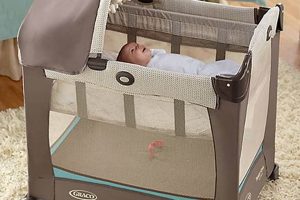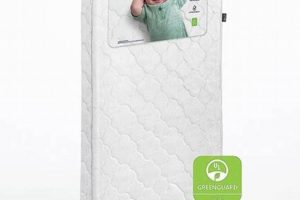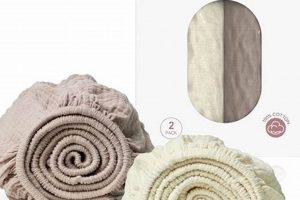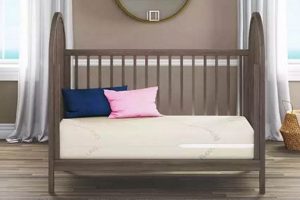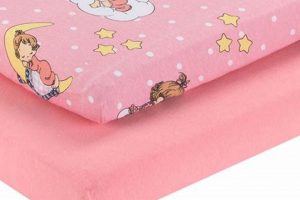An essential bedding item safeguards an infant’s sleeping surface from liquids, allergens, and other potential contaminants. This covering typically consists of a waterproof or water-resistant membrane bonded to a fabric layer, offering a hygienic barrier. For example, a parent might place this product on the baby’s bed beneath the fitted sheet to maintain a clean and healthy sleeping environment.
The utilization of this protective measure offers several key advantages. It prolongs the life of the underlying sleep surface by preventing stains and damage from spills or accidents. Furthermore, many options are designed to be hypoallergenic, reducing the risk of allergic reactions to dust mites and other common irritants. Historically, such protection focused primarily on basic waterproofing, but contemporary designs incorporate breathability and enhanced comfort features.
The subsequent sections will delve into specific considerations for selecting a suitable option, including material types, safety standards, proper cleaning techniques, and disposal considerations. Understanding these aspects ensures informed decision-making for creating a secure and sanitary sleep space for infants.
Essential Considerations for Maintaining a Crib Mattress Protector
The following guidelines provide essential information to ensure optimal performance and longevity of this crucial nursery item.
Tip 1: Prioritize Certified Safety Standards: Verify compliance with established safety regulations, such as those set forth by ASTM International or similar bodies. This ensures the item has undergone rigorous testing for harmful chemicals and flammability.
Tip 2: Select Appropriate Materials: Consider materials that offer both effective protection and breathability. Polyurethane laminates, while waterproof, may lack optimal airflow. Alternatives include breathable membranes combined with natural fibers like cotton or bamboo.
Tip 3: Adhere to Washing Instructions: Always follow the manufacturer’s guidelines for laundering. High heat or harsh chemicals can degrade the protective layer, reducing its effectiveness. Gentle cycles and mild detergents are generally recommended.
Tip 4: Promptly Address Spills: Attend to spills and accidents immediately to prevent penetration into the underlying mattress. Excess liquid should be blotted with a clean cloth before laundering the cover.
Tip 5: Regularly Inspect for Damage: Periodically examine the surface for tears, punctures, or delamination. Compromised areas may no longer provide adequate protection and necessitate replacement.
Tip 6: Consider Waterproof vs. Water-Resistant Options: A waterproof option provides an impermeable barrier, while a water-resistant one offers limited protection. The choice depends on anticipated usage and level of needed defense.
Tip 7: Choose a Fitted Style: Opt for a fitted style with elasticized edges to ensure a secure and snug fit on the mattress. This minimizes shifting and potential exposure.
Implementing these tips enhances the item’s functionality, extending its lifespan and optimizing hygiene within the infant’s sleep environment.
The concluding section will present a comprehensive overview and final recommendations.
1. Waterproof Barrier
The primary function of the a specific item designed for infant bedding is to provide a waterproof barrier. This barrier prevents liquids, such as spills, bodily fluids, and other potential contaminants, from penetrating the sleep surface. The absence of this barrier results in the absorption of these substances, leading to potential bacterial growth, unpleasant odors, and ultimately, damage to the underlying mattress. For example, a leaky diaper without adequate protection can saturate the mattress core, rendering it unsanitary and potentially unusable.
The composition of the barrier often involves a thin, impermeable membrane, typically made of polyurethane or similar materials. This membrane is bonded to a fabric layer, providing both protection and a degree of comfort. The effectiveness of this barrier is crucial; a compromised membrane due to wear, tear, or improper cleaning methods negates the intended protection. Routine maintenance, including regular inspection and adherence to washing instructions, is necessary to preserve the integrity of this waterproof layer. The selection of the specific item should prioritize verified waterproof capabilities, often indicated by testing certifications and material specifications.
In summary, the waterproof barrier serves as the foundational element of a specific item designed for infant bedding, safeguarding against liquid damage and maintaining a hygienic sleeping environment. Challenges related to material durability and proper maintenance require ongoing attention to ensure the continued effectiveness of this protection. The performance of this component directly impacts the health and longevity of the underlying mattress, emphasizing its practical significance.
2. Hypoallergenic Properties
The integration of hypoallergenic properties into coverings designed for infant bedding directly addresses potential allergic reactions and sensitivities in infants. This is a critical consideration due to the heightened vulnerability of infants to environmental allergens during their early developmental stages. The implementation of such properties aims to create a sleeping environment that minimizes exposure to common irritants.
- Material Composition and Allergen Exclusion
Hypoallergenic options are frequently constructed from materials specifically chosen for their low allergenic potential. Examples include tightly woven fabrics that limit dust mite penetration, and materials certified free from harmful chemicals or dyes that may trigger allergic responses. The role of these materials is to create a barrier that physically excludes allergens, mitigating the risk of sensitization or allergic reactions in the infant.
- Reduction of Dust Mite Colonization
Dust mites are a prevalent allergen in indoor environments. Hypoallergenic coverings minimize dust mite colonization through the use of tightly woven fabrics and, in some cases, antimicrobial treatments. This reduction in dust mite populations directly translates to a decrease in allergen exposure for the infant during sleep, thereby reducing the likelihood of allergic symptoms.
- Chemical Sensitivity Mitigation
Infants can exhibit sensitivities to chemicals used in textile manufacturing, such as formaldehyde or certain dyes. Hypoallergenic bedding options often undergo rigorous testing and certification to ensure they are free from these potentially irritating substances. By minimizing chemical exposure, these coverings contribute to a healthier sleep environment, reducing the risk of skin irritation or respiratory distress.
- Moisture Management and Mold Prevention
Some hypoallergenic coverings incorporate moisture-wicking properties, which assist in maintaining a dry sleeping surface. This is significant because a damp environment can promote the growth of mold and mildew, both of which are potent allergens. By managing moisture levels, these coverings indirectly contribute to the reduction of allergenic triggers within the infant’s sleep space.
The incorporation of hypoallergenic features into these covers is a proactive measure to minimize infant exposure to common allergens. The selection of materials, reduction of dust mite colonization, mitigation of chemical sensitivities, and management of moisture levels collectively contribute to a healthier sleep environment. By understanding the role of these properties, caregivers can make informed decisions to protect their infants from potential allergic triggers during sleep.
3. Breathability
Breathability is a critical attribute of materials used in infant bedding, particularly in conjunction with mattress coverings. It directly impacts the infant’s sleep environment by influencing temperature regulation and moisture control. Inadequate breathability can lead to overheating and increased risk of discomfort, while sufficient breathability promotes a more stable and comfortable sleep environment.
- Temperature Regulation
A highly breathable mattress covering facilitates air circulation, allowing body heat to dissipate effectively. This prevents the buildup of excessive warmth, which is especially important for infants who have limited ability to regulate their own body temperature. For example, a covering made with a tightly woven, non-breathable material can trap heat, leading to discomfort and potential overheating, while a breathable material allows for better airflow and temperature balance.
- Moisture Management
Breathable materials allow moisture vapor, such as sweat, to pass through the fabric and evaporate. This helps to keep the sleep surface dry, reducing the risk of skin irritation and the growth of mold or bacteria. Conversely, a non-breathable covering can trap moisture against the skin, creating a damp environment that promotes discomfort and potential health issues.
- Material Selection and Construction
The breathability of a mattress covering is determined by both the type of material used and the method of construction. Natural fibers, such as cotton and bamboo, are generally more breathable than synthetic materials like vinyl. Furthermore, looser weaves and open-cell foam structures allow for greater airflow compared to tightly packed materials. Manufacturers often use specific construction techniques to enhance breathability, such as incorporating ventilation holes or using multiple layers of breathable fabric.
- Impact on Sleep Quality
Adequate breathability contributes to a more comfortable and stable sleep environment, leading to improved sleep quality for the infant. A baby who is too hot or too damp is more likely to wake up frequently and experience restless sleep. By promoting temperature regulation and moisture management, a breathable mattress covering can help to create a more conducive environment for restful sleep.
The breathability of materials in a protective layer designed for infant bedding is not merely a comfort feature but a crucial aspect of infant health and well-being. The selection of breathable materials and construction techniques directly impacts temperature regulation, moisture management, and overall sleep quality. Manufacturers and caregivers alike must prioritize breathability to ensure a safe and comfortable sleep environment for infants.
4. Secure Fit
The attribute of secure fit is paramount when evaluating the functionality of a covering intended for an infant’s sleep surface. Its relevance lies in ensuring both the protection of the mattress and the safety of the infant. A poorly fitting item may compromise its intended purpose and pose potential hazards.
- Prevention of Mattress Exposure
A secure fit ensures complete coverage of the mattress, preventing direct contact with fluids, allergens, and other contaminants. Ill-fitting options may leave areas of the sleep surface exposed, negating the protective benefits. For instance, if the elasticized edges are too loose, the covering could shift, leaving portions of the mattress vulnerable to spills or accidents.
- Minimization of Bunching and Wrinkling
A snug fit reduces the likelihood of bunching or wrinkling of the material. Excess material can create uncomfortable pressure points for the infant and potentially disrupt sleep. A securely fitted covering maintains a smooth, even surface, contributing to a more comfortable and safer sleep environment.
- Reduction of Entrapment Risk
A secure fit is critical for minimizing the risk of entrapment. Loose or ill-fitting coverings can become dislodged, creating gaps or folds where an infant could become entangled. Properly fitted options with strong elasticized edges help to prevent this hazard by maintaining a taut and secure position on the mattress.
- Maintenance of Functionality During Use
A secure fit ensures that the product remains in place throughout the duration of use. Frequent movement or adjustments can compromise its effectiveness. A well-fitted covering stays securely attached to the mattress, even during periods of active movement by the infant, providing continuous protection.
The interrelationship between a secure fit and these products is foundational to its practical application. By preventing mattress exposure, minimizing bunching, reducing entrapment risk, and maintaining functionality, a secure fit contributes significantly to the safety and hygiene of the infant’s sleep environment. This attribute should be a primary consideration when selecting a protective option for an infant’s mattress.
5. Durability
Durability, in the context of coverings for infant bedding, refers to the ability to withstand wear, tear, and degradation over extended use. This attribute is crucial for ensuring the continued effectiveness and longevity of the protective layer, impacting both hygiene and cost-effectiveness.
- Material Resistance to Degradation
The composition of the materials directly influences resistance to degradation from washing, abrasion, and prolonged exposure to moisture and bodily fluids. Options made from high-quality fabrics and waterproof membranes are less susceptible to breakdown compared to those made from cheaper, less resilient materials. For example, a covering with a delaminating waterproof layer quickly loses its protective qualities, requiring premature replacement.
- Seam Strength and Construction
Seam strength is a critical factor in the overall durability of these protective layers. Weak or poorly constructed seams are prone to tearing or separation, compromising the integrity of the barrier. Reinforced seams and robust stitching methods contribute to greater resistance against stress and strain during regular use and laundering. A covering with frayed or broken seams is no longer fully effective in preventing liquid penetration.
- Resistance to Punctures and Tears
The ability to resist punctures and tears from sharp objects or rough handling is essential for maintaining the protective function. Thicker materials and tighter weaves offer greater resistance to damage compared to thinner, more delicate fabrics. For example, a small tear can compromise the waterproof barrier, allowing liquids to seep through and contaminate the mattress. Regular inspection and careful handling are necessary to minimize the risk of such damage.
- Longevity Through Repeated Laundering
The ability to withstand repeated laundering without significant degradation is a key indicator of durability. Frequent washing is necessary to maintain hygiene and remove contaminants, so the material’s ability to retain its shape, waterproof properties, and structural integrity is critical. Protective layers that shrink, fade, or lose their waterproof qualities after a few washes are considered less durable and offer a shorter lifespan.
These facets collectively determine the lifespan and effectiveness of the infant bedding layer. A focus on durable materials, robust construction, and resistance to degradation ensures long-term protection, contributing to a cleaner, safer, and more cost-effective solution for managing infant bedding hygiene. Purchasing durable items is always a smart idea because it gives a long-term value to this bedding essential.
6. Ease of Cleaning
The ease with which a particular item designed for infant bedding can be cleaned directly influences the hygiene and maintenance of the infant’s sleep environment. The protective layer’s primary purpose is to prevent liquids and other contaminants from reaching the underlying mattress. Consequently, the ability to effectively and efficiently remove these substances from the protector’s surface is crucial for preventing bacterial growth, odor accumulation, and potential allergen buildup. For instance, a protector that can be quickly wiped down after a minor spill minimizes the risk of stains and the need for frequent laundering.
The material composition and design of the protector significantly impact its cleanability. Options constructed from smooth, non-absorbent materials, such as polyurethane laminates or tightly woven fabrics with a water-resistant finish, generally facilitate easier cleaning compared to those made from textured or porous materials. Furthermore, protectors that are machine washable and dryer-safe offer a convenient and time-saving method for thorough cleaning. Real-world scenarios highlight the practical advantages of prioritizing cleanability. Consider the case of a parent managing multiple infants or facing time constraints; the ability to quickly clean a protective layer becomes essential for maintaining a sanitary sleep environment without excessive effort. Likewise, during illness or periods of frequent accidents, the convenience of machine washing and drying can greatly reduce the burden on caregivers.
In summation, the cleanability of a protective bedding item is a critical determinant of its overall value and practicality. By facilitating efficient removal of contaminants, it ensures the maintenance of a hygienic sleep surface, reduces the risk of bacterial growth, and alleviates the cleaning burden on caregivers. This feature is a vital attribute to consider when selecting a specific option for an infant’s bedding, directly impacting the ease and effectiveness of maintaining a clean and healthy sleep environment.
Frequently Asked Questions
This section addresses common inquiries regarding a specific item designed for infant bedding. The information presented aims to clarify functionality and provide practical guidance for optimal use.
Question 1: What is the intended purpose of this protective item?
The primary function is to create a barrier against liquids, allergens, and other contaminants, preventing them from reaching and damaging the crib mattress. It extends the mattress’s lifespan and maintains a sanitary sleep environment.
Question 2: What materials are commonly used in production of this product and what are their pros and cons?
Common materials include polyurethane laminates (waterproof but potentially less breathable), cotton blends (breathable but may offer limited waterproofing), and bamboo fibers (naturally hypoallergenic and breathable). The selection depends on the balance between protection and comfort.
Question 3: How frequently should these items be cleaned?
It should be cleaned immediately after any spill or accident. Regular washing, typically every 1-2 weeks, is also recommended to maintain hygiene and prevent the buildup of allergens.
Question 4: Can this protector be placed directly under the infant?
No, it must be used beneath a fitted sheet. Direct contact may cause discomfort or overheating. The fitted sheet provides a comfortable and breathable surface for the infant to sleep on.
Question 5: How can it be determined if the protector meets established safety standards?
Verify that the product is certified by organizations such as ASTM International or OEKO-TEX. These certifications indicate that the item has been tested for harmful chemicals and flammability.
Question 6: What are the disposal guidelines for this item?
Check local regulations for textile recycling options. If recycling is unavailable, the item can be disposed of with regular waste. Consider donating if the item is still in good condition.
In summary, a specific item designed for infant bedding plays a vital role in maintaining a clean and safe sleep environment. Careful selection, proper maintenance, and adherence to safety guidelines ensure optimal performance and longevity.
The subsequent section will provide a comprehensive overview of all topics discussed.
Crib Mattress Protector
This exploration of the crib mattress protector has underscored its importance in maintaining a hygienic and safe sleep environment for infants. Key attributes such as waterproof capabilities, hypoallergenic properties, breathability, secure fit, durability, and ease of cleaning are critical in ensuring effective protection and long-term value. Proper material selection, construction techniques, and adherence to maintenance guidelines contribute to optimal performance and longevity.
Careful consideration of the aspects discussed is essential for informed decision-making. Prioritizing these factors not only safeguards the infant’s health and well-being but also provides a cost-effective solution by extending the lifespan of the underlying mattress. Responsible utilization of this protective item is a crucial aspect of providing a secure and sanitary start for every child.


